Some of my earliest junior golf tournament memories reach back to rounds at Mid Pines on trips with my Dad. I grew up in Asheville, N.C., so at least once a year we’d journey down to Pinehurst for a junior tournament or two. The tournaments were often played over a number of area courses, but it seemed like Mid Pines was always in the rotation.
It wasn’t until my college days that I played Mid Pines with an architectural eye. At the end of my junior summer in 2013—two years after starting this site—I returned to Mid Pines to see the renovation work that Kyle Franz had just completed. Just two days prior to that round I played the newly renovated Pinehurst No. 2, and the combination of those two courses deepened my appreciation for Donald Ross.
Mid Pines is located a few miles from the Village of Pinehurst, where Donald Ross lived for much of his career. After he built the first four courses at Pinehurst Resort, he turned his attention to Mid Pines, which was his fifth design in the area. It was 1920 and the idea was to create a private course for locals as the resort was often very busy.
Ross opened the course in 1921 and it was immediately considered one of his best. He used the rolling Sandhills terrain perfectly and the overall design remains largely unchanged to this day. The renovation work in 2013 by Kyle Franz simply reversed what could be called, “signs of aging.” Many of the greens had shrunk over the decades, a few troublesome trees has grown into play, bunkers had lost their shape, and expanses of rough had replaced wire grass waste areas.
Franz used aerial images from the Tufts Archives (a must-visit in the Village of Pinehurst) to determine original green sizes, original trees, original fairway shapes, and he went about restoring the course to its roots.
The renovation work reinvigorated the place and restored a lot of Mid Pines’ charm. Expanding the greens recovered lost pin positions and re-doing the bunkering brought strategy back into play on holes where rough had diminished it.
A common complaint about Mid Pines is its length. The tips max out at 6,723 yards and the next longest set only touches 6,123. The lack of length is really felt in the par 5s, where long hitters can comfortably reach every one on the course.
Despite the relatively short length, you can’t really bomb and gauge your way to a good score at Mid Pines. The fairways are often wide, but the playing corridors aren’t much wider than the fairways. If you miss the short stuff, you’re almost certainly in a waste area, pine needles, or in both amongst the trees.
Placing your tee shots and having the best angle into the greens is much more important than length off the tee. During two rounds at Mid Pines on my last trip I watched some long hitters struggle at Mid Pines after going low across the street at the longer Pine Needles. Trying to muscle your way around the course without engaging in the strategy can end in big numbers.
Hole #1 – 365 yards – The opening hole plays down to the bottom of a valley with a blind shot back up to the green. The putting surface slopes from right to left and is much deeper than it appears. I’d bet that few balls ever reach a middle or back pin during first time rounds.
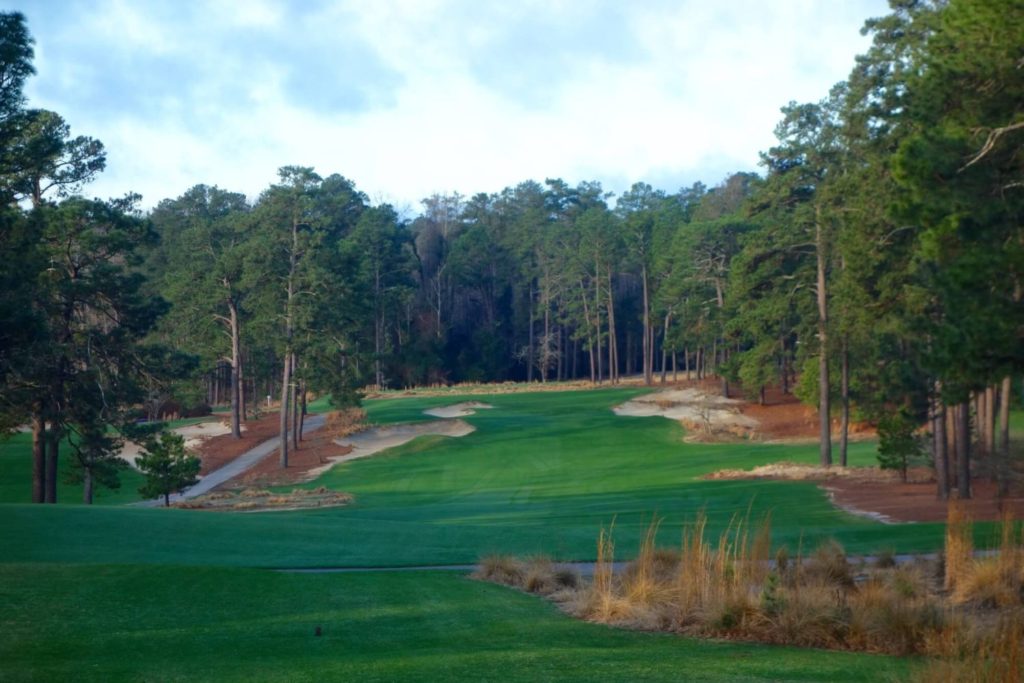
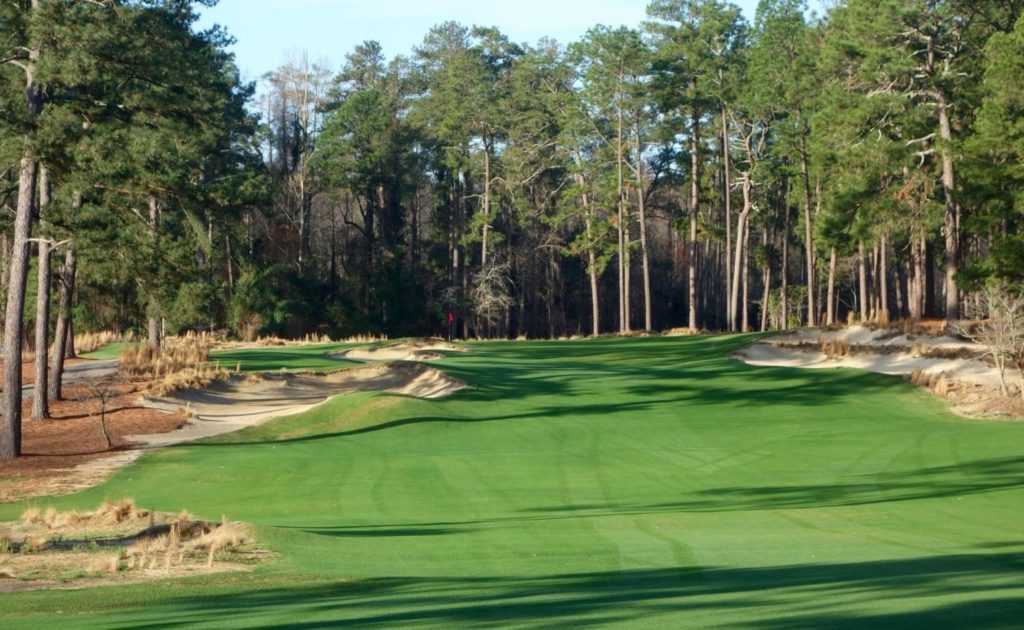
Hole #2 – 162 yards – This beautiful par 3 requires a demanding shot early in the round. As with the first, the green is deeper than you think, so there’s not a good reason to challenge the deep front right bunker.
Hole #3 – 386 yards – This dogleg right is one of the few weak holes on the course, and that’s only because of the tee shot. The drive plays over a pond into the fairway at an awkward angle. Anything too far right ends in a wet hazard area that borders the hole. The smart play is a long iron or wood over the right edge of the pond, leaving a roughly 150 yard uphill shot into the green.
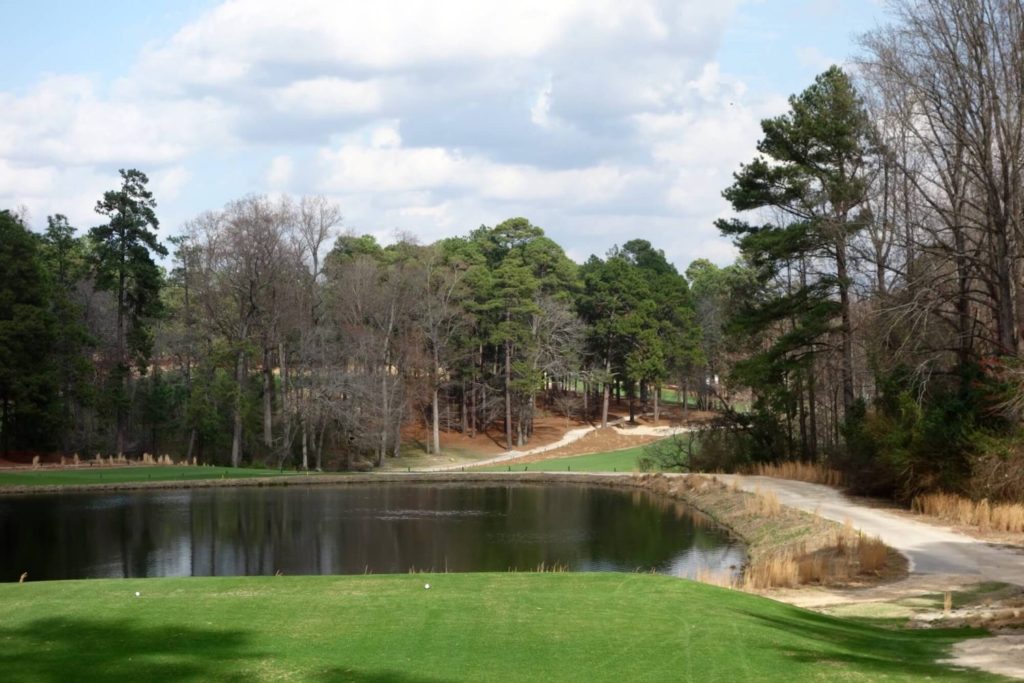
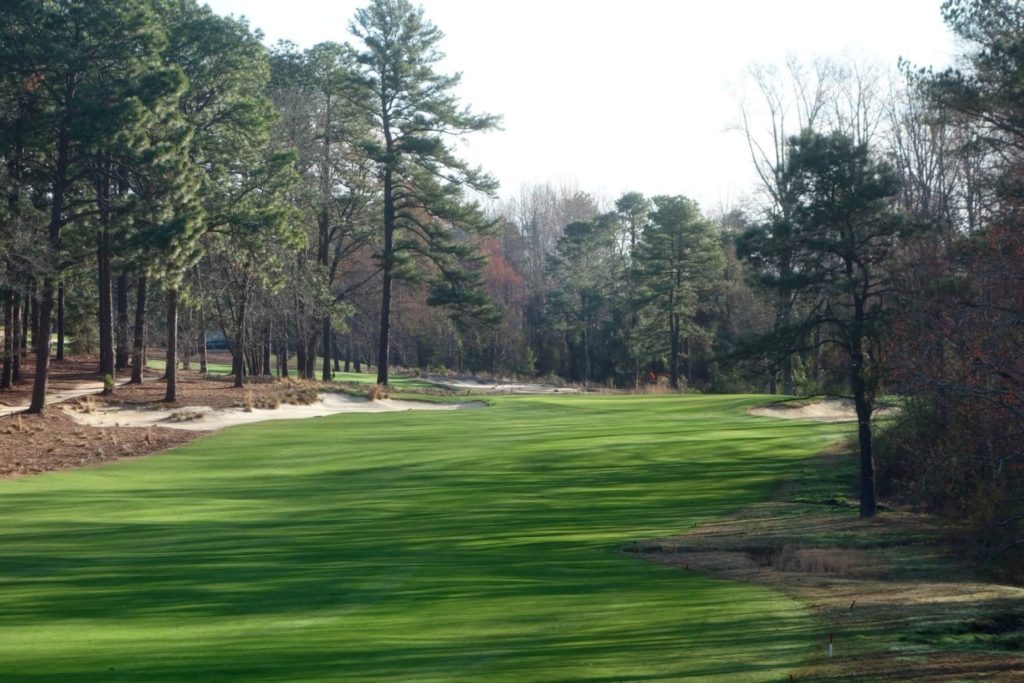
Hole #4 – 309 yards – This short uphill par 4 is a tricky one and during my latest trip was the topic of debate. Some players thought it best to hit a mid or long iron down the left. Others thought driver at the left edge of the green was the play. Everyone agreed that right, where you’re blocked by tall trees, is the worst miss. The green is shallow and sloping with a bunker and collection areas deep. You could easily gloss over this hole rushing around, but it’s a great strategic point in the design.
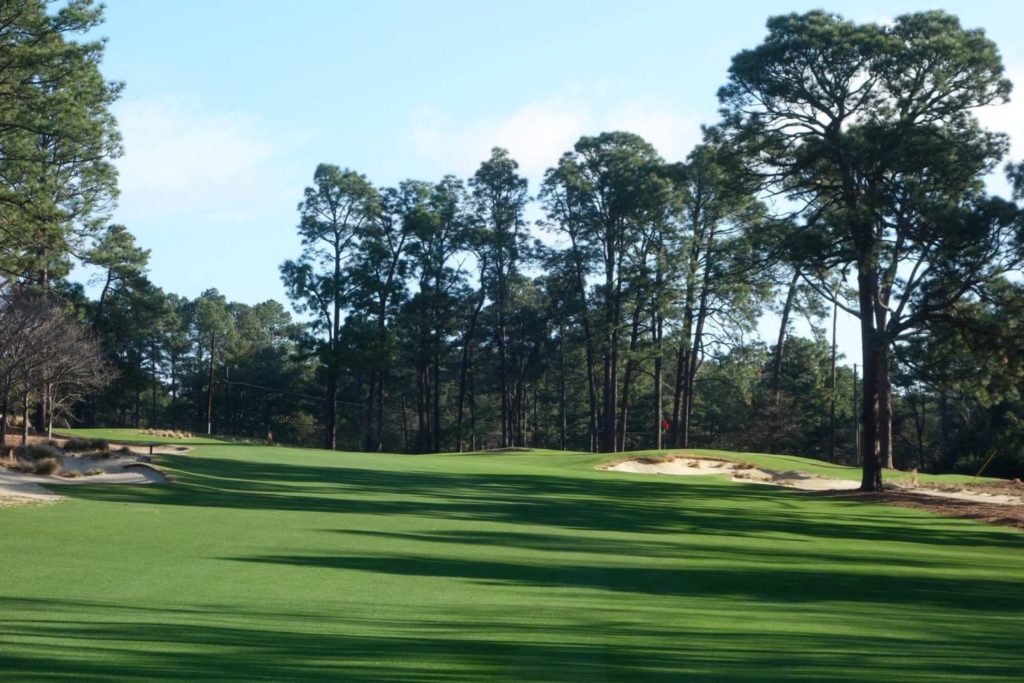
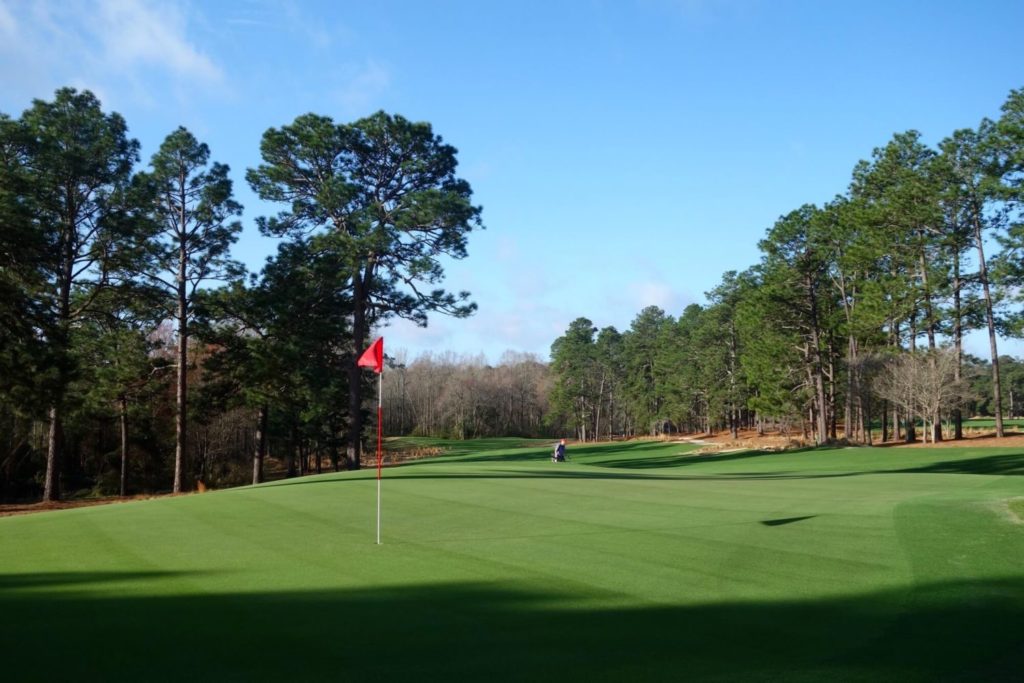
Hole #5 – 458 yards – This short par 5 has one of the most picturesque approaches on the course. The best line is down the right side where longer players catch a slope. Long hitters can also reach a small pond on the left side of the fairway. The green is surrounded by bunkers and a false front, which makes for tough up and downs. The hole is parallel to the first and plays across the same valley.
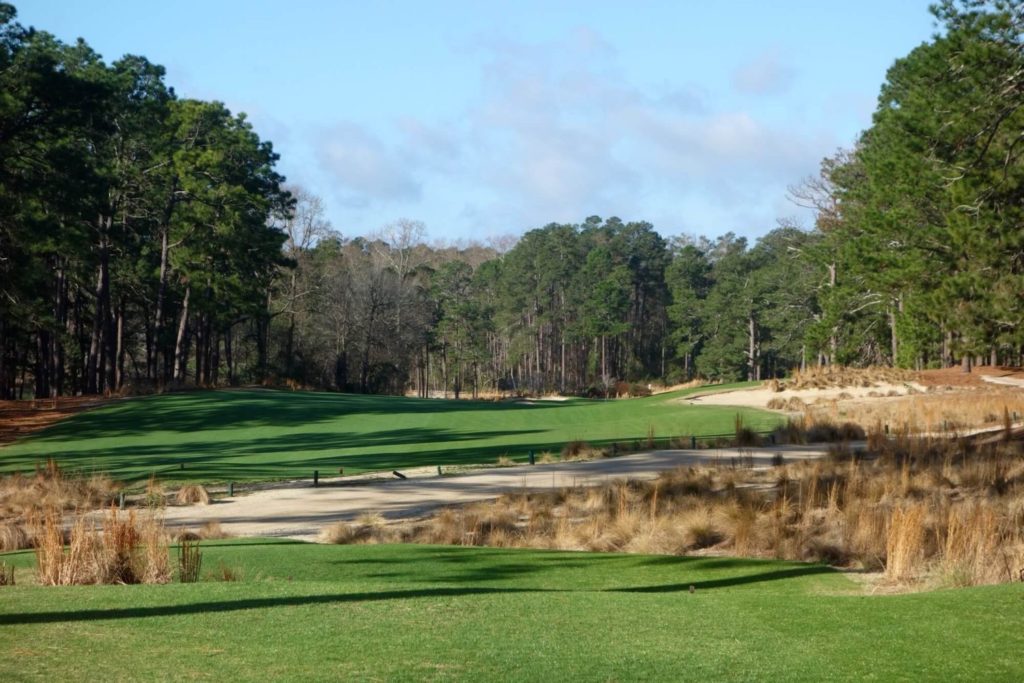
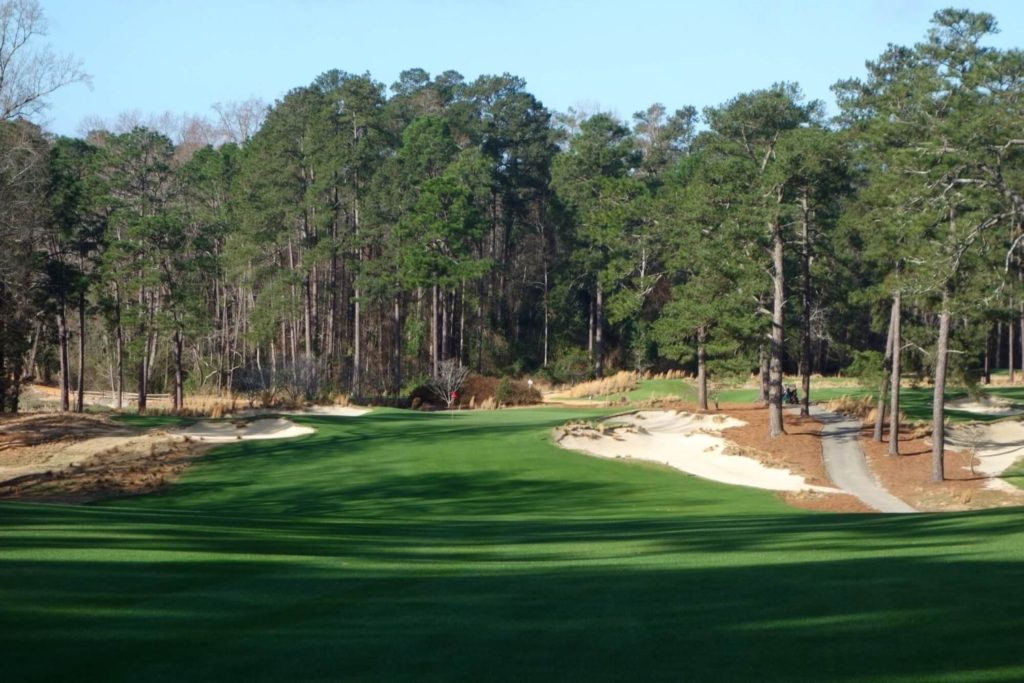
Hole #6 – 480 yards – Waste areas and trees flank both sides of this fairway all the way to the green. Long hitters can reach this par 5 in two, where the biggest challenge is avoiding the front left bunker and any trees along the way. The short drone clip below flies from the green back toward the tee.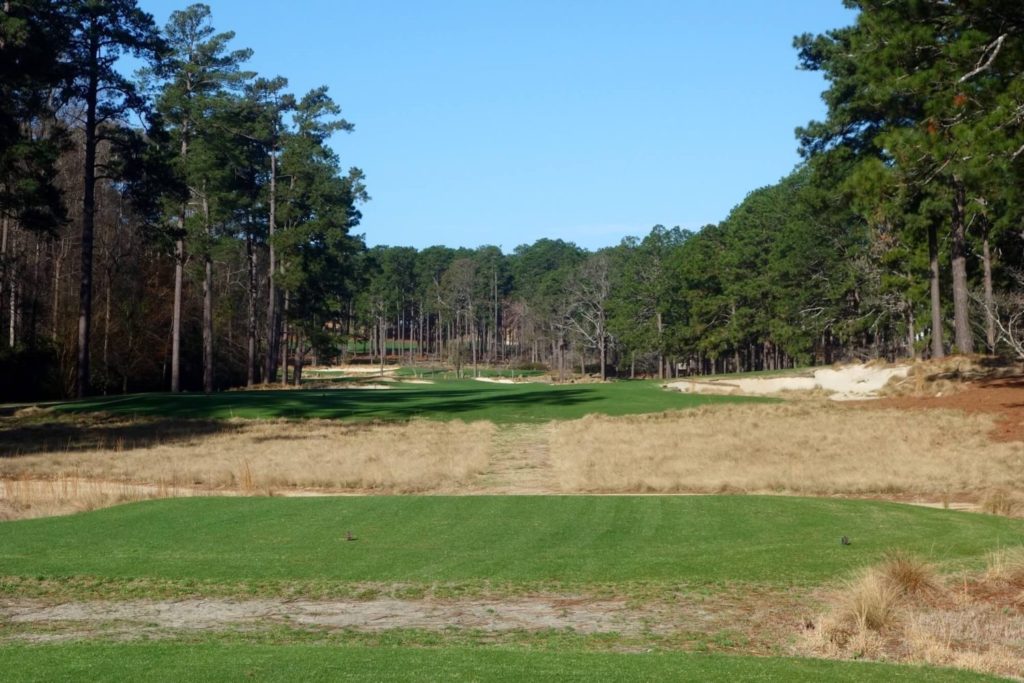

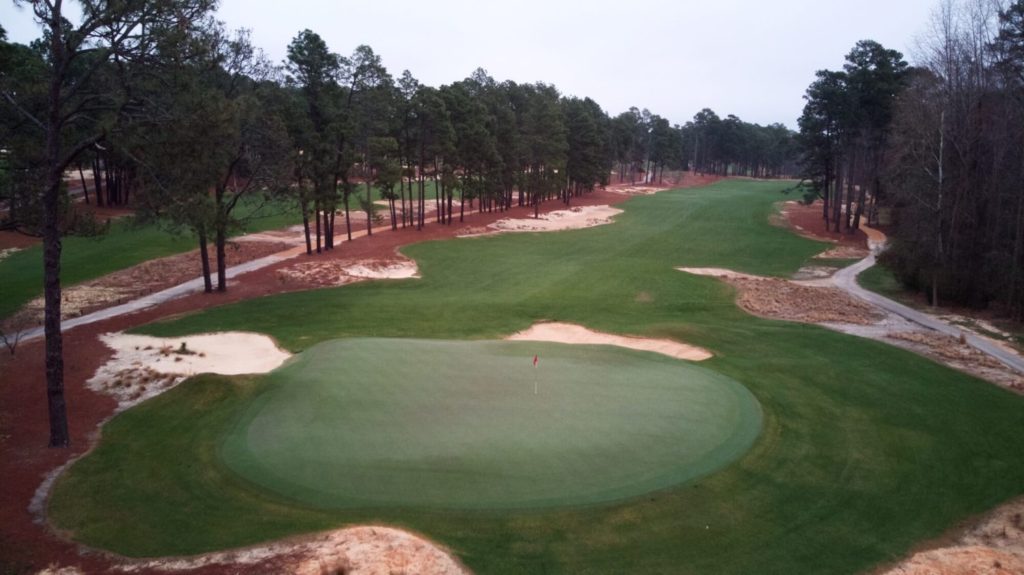
Hole #7 – 366 yards – The left side provides the best angle into this par 4 where the fairway kicks everything right. Anything too far right is blocked by a lone tree at the end of the fairway and the green is multi-tiered, so distance control is key.

Hole #8 – 165 yards – This downhill par 3 is one of my favorite on the course. The back of the green is built up so that even on a downhill hole, the green works back to front. It also means that if you miss long, you’re roughly 20 feet below the surface of the green.
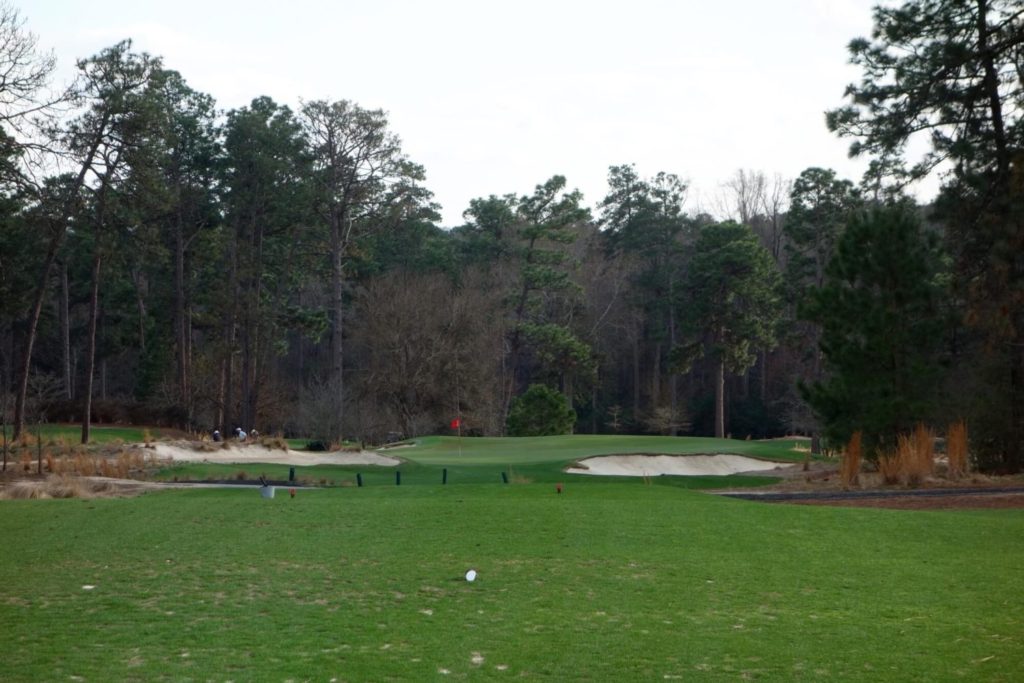
Hole #9 – 324 yards – This short par 4 requires two smart shots. 220 yards gets you to the perfect landing zone, but anything too long runs through the fairway into waste area and trees. From the landing area it’s a birdie opportunity with a short wedge into the green. 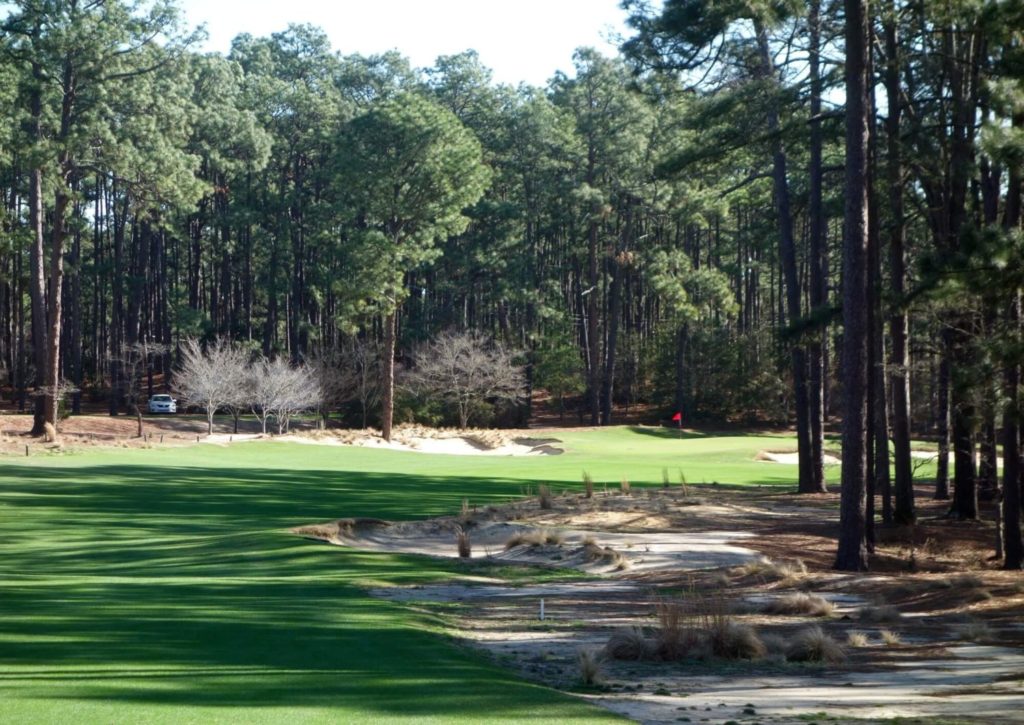
Hole #10 – 485 yards – By now you’ve seen the theme of short par 5s. This is another, but on this one long hitters have a real advantage. Roughly 270 yards from the tee lies the top of a hill. Players that get on top of the hill can see the green and have a good chance to get on in two. Anything short of the hilltop leaves a blind layup, which while not too difficult, makes for a much harder birdie.
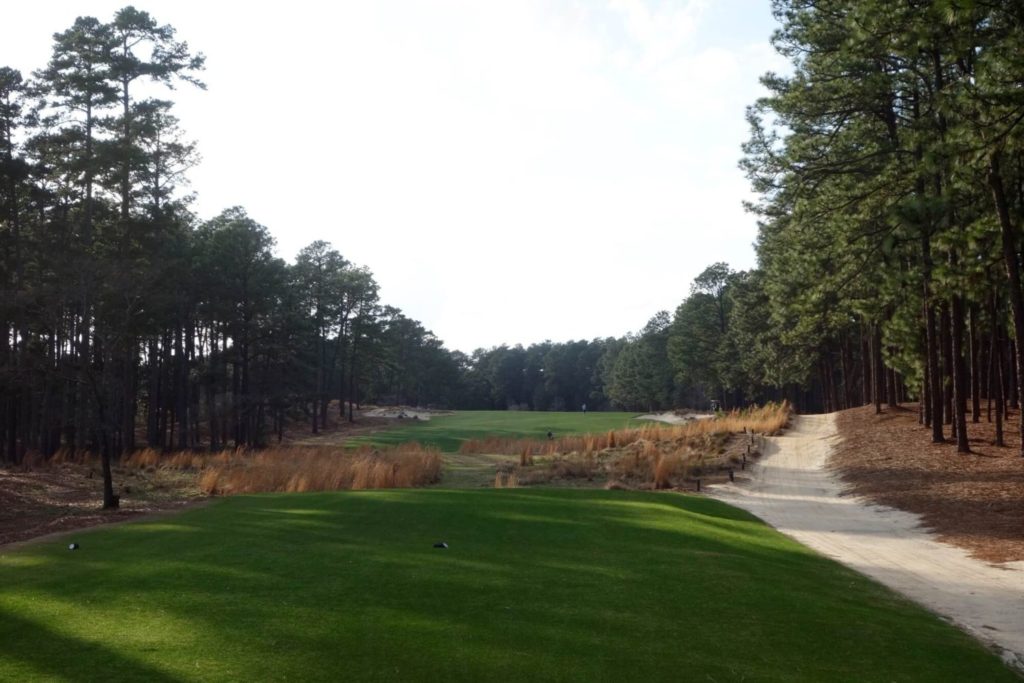

Hole #11 – 165 yards – This par 3 is slightly downhill from an elevated tee, so it plays half a club shorter than the yardage. A knob front right repels short shots and kicks good shots left toward the center of the putting surface.
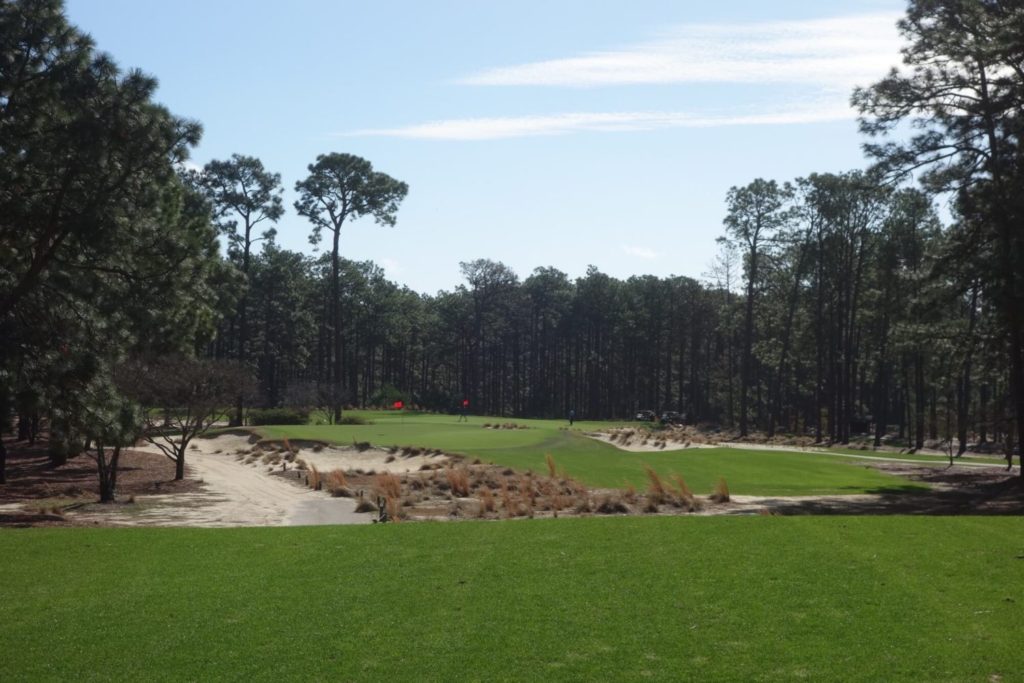
Hole #12 – 360 yards – When we asked one of the superintendents at Mid Pines which hole was his favorite, he said the twelfth because of its strategy. The easiest and safest drive aims out to the right where there is plenty of open space. That play leaves the hardest approach and angle into the green, though. The toughest drive challenges the left bunkers, and the reward is a much easier approach shot where you don’t have to challenge the greenside bunkers. It’s a perfect example of strategic design where risky or bold play is rewarded and safer play, while not punished, is met with a much more demanding second shot.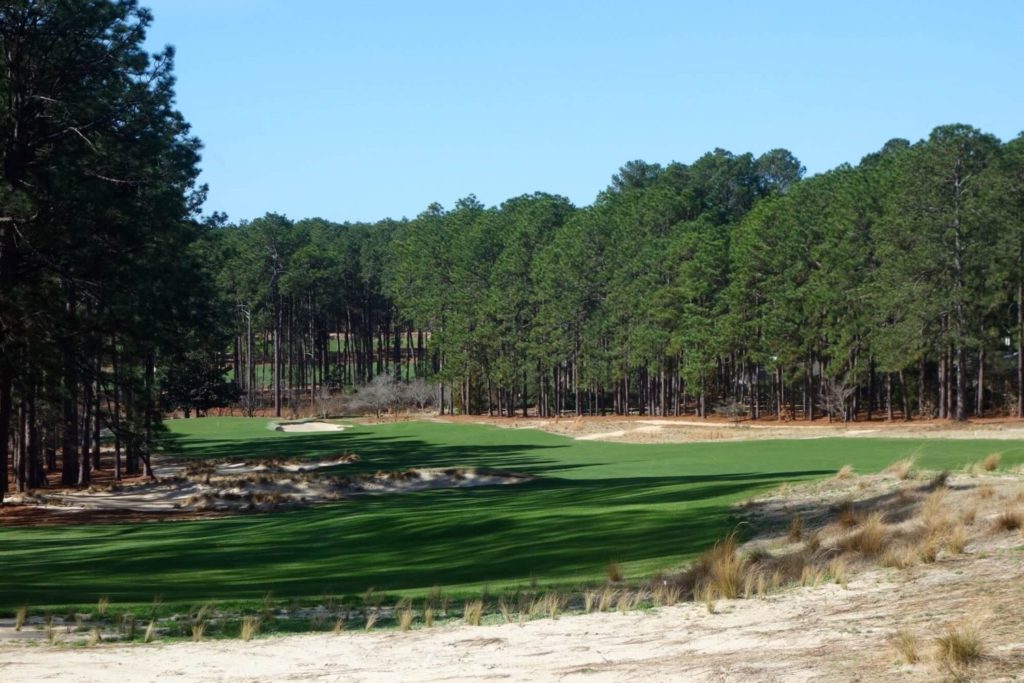
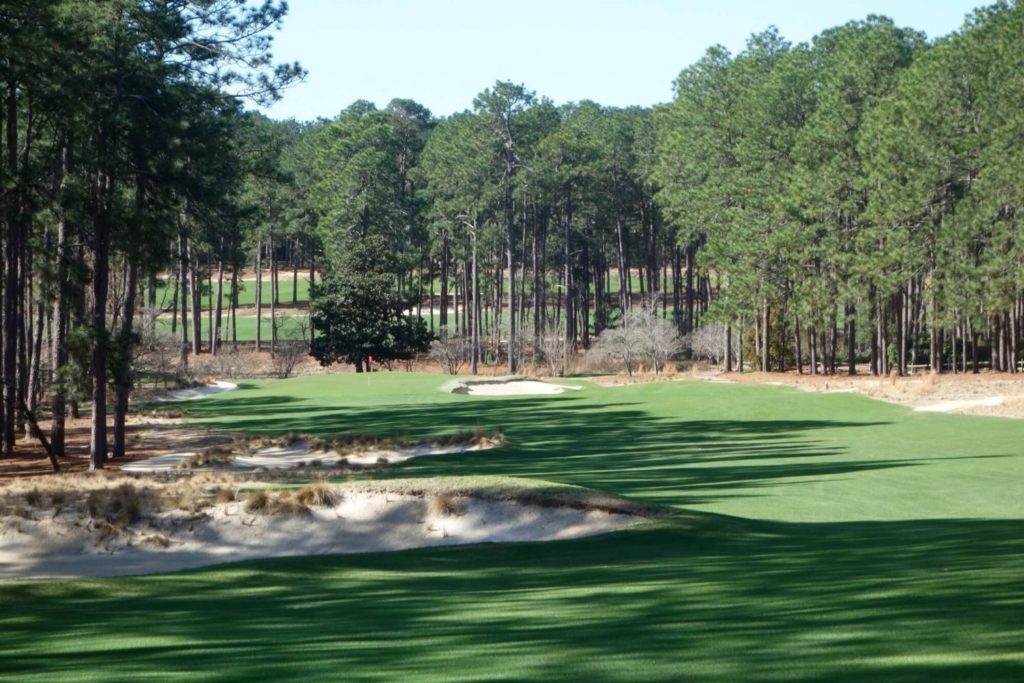
Hole #13 – 192 yards – This long par 3 (230+ from the tips!) plays to a large green that slopes from right to left. No matter where the pin is, the hole requires a well-struck long iron or hybrid. Enjoy the short drone video below that gives a good sense of the hole.
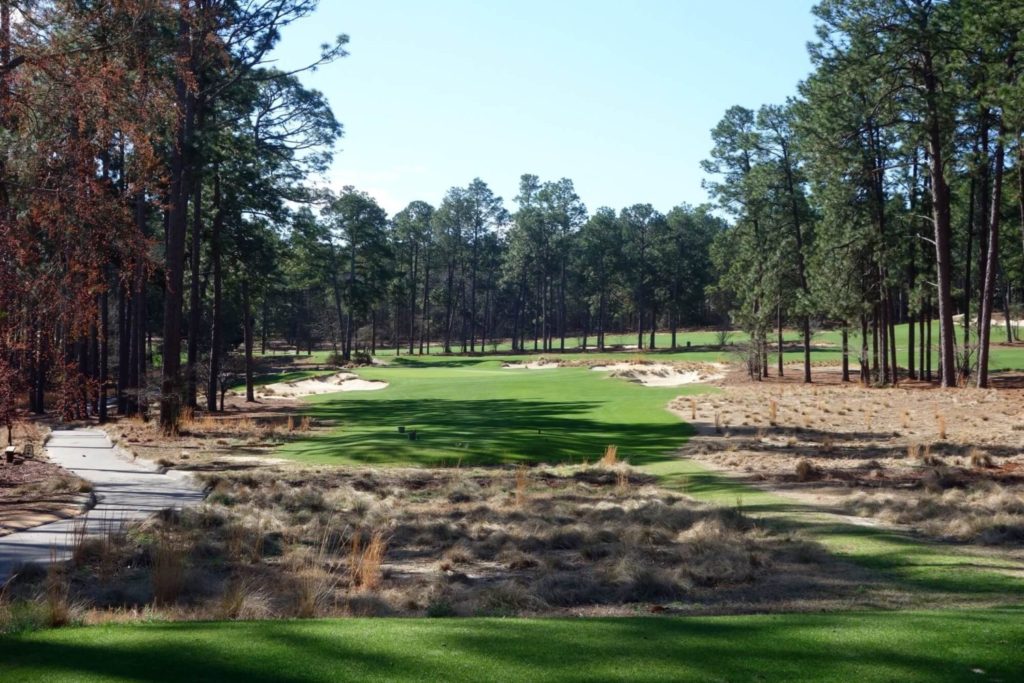
Hole #14 – 343 yards – This is another uphill par 4 where the fairway kicks balls to the right. The approach to the green is uphill, so you don’t get a sense of what surrounds the green or its depth. The approach from the fairway is blind but the second shot below, taken with my drone, shows the green shape and bunkering.


Hole #15 – 478 yards – The final par 5 plays down to a valley and back up to the green. As with the 12th hole, the easiest drive is out to the right, but that angle into the green brings in the right waste area and a green that slopes away from you (not to mention a sidehill lie). Drives down the left challenge the left waste area, but leave a much better approach angle and stance.

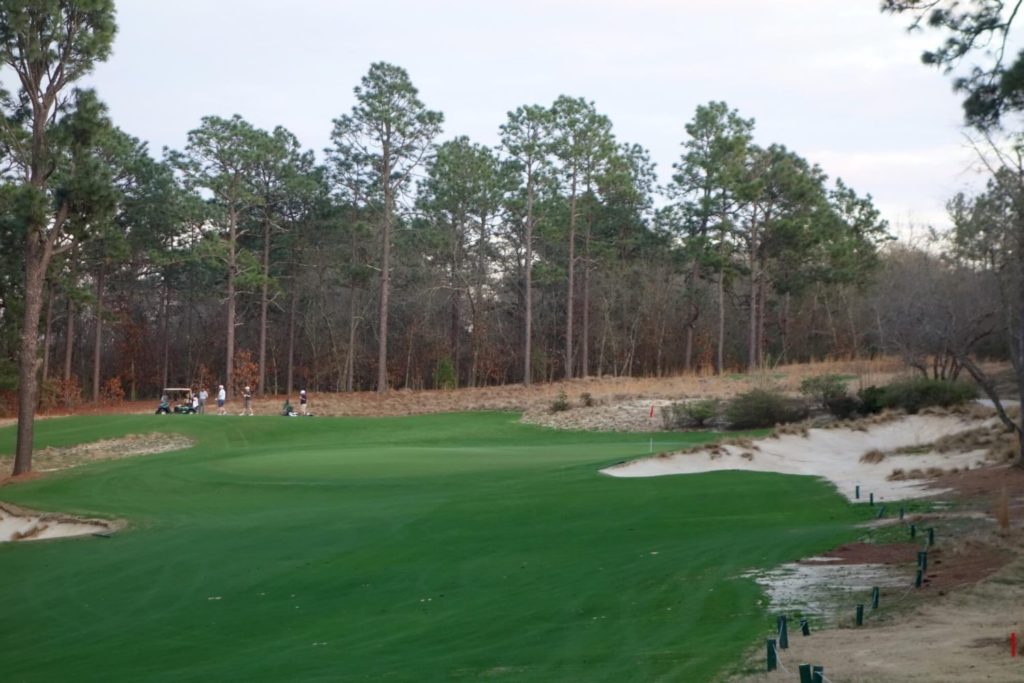
Hole #16 – 376 yards – The dogleg left 16th is a hole and view that sticks in your head. The tee shot plays straight downhill to a wide fairway and not much is gained from challenging the corner. From the landing area it’s a straight approach to crowned green.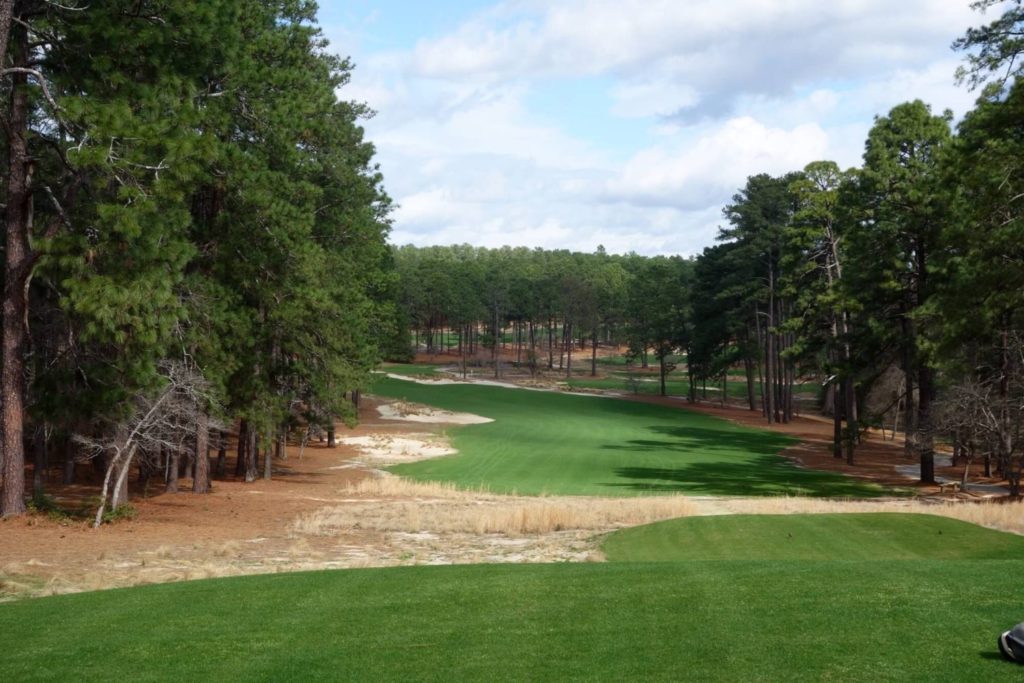
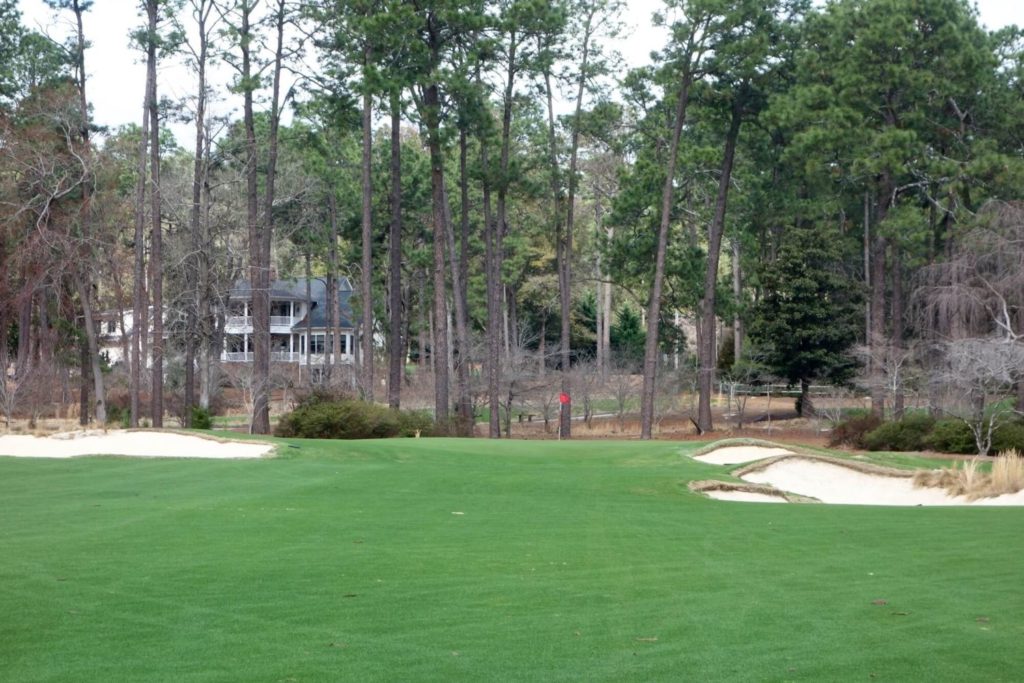
Hole #17 – 362 yards – The dogleg right penultimate hole requires an accurate tee shot through a gap in the trees in front of the tee. The green is crowned like many you’d find over on Pinehurst No. 2. Distance control is key with the false front and multiple slopes on this green.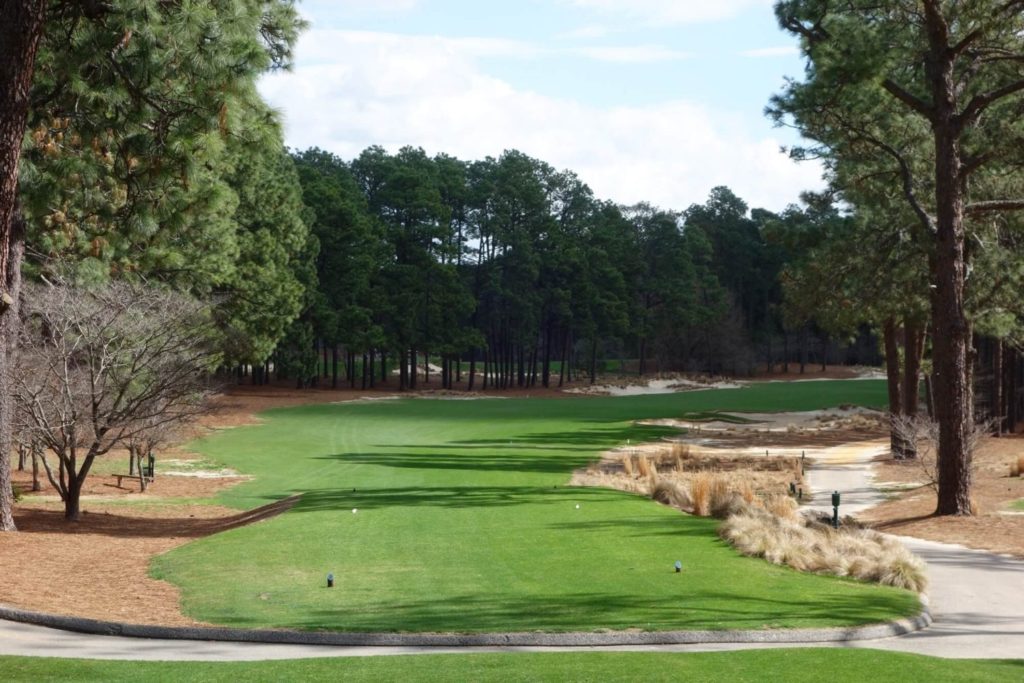

Hole #18 – 392 yards – This dogleg left final hole ends the round on a great note. A long iron reaches the left bend where golfers turn the corner to see the green framed by the iconic Mid Pines Inn. The hole provides a very good chance at a last birdie to cap the round.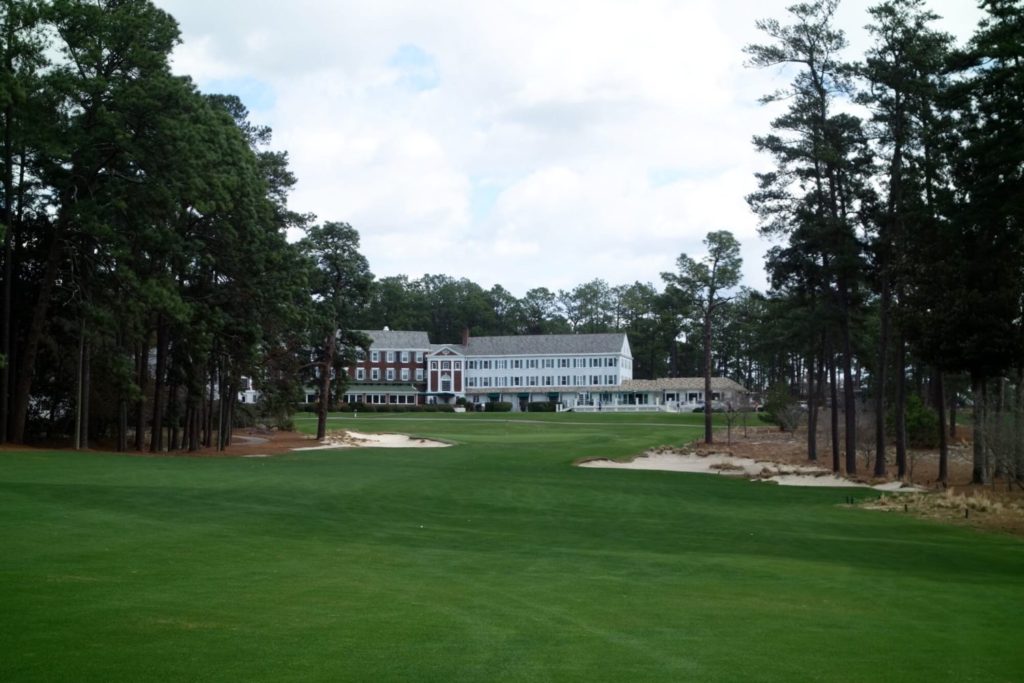
Some of my favorite rounds in the Pinehurst area have taken place at Mid Pines. Detractors say the course isn’t long enough to hang with the top tournament layouts, but what the course lacks in length it gains in strategy. Lazy or thoughtless play is punished by cut off angles and trees, pine straw, and waste areas. To score well you have to think your way around the course.
The recent renovation work at Mid Pines has totally restored the charm of the place. I rank it among my favorites in the greater Pinehurst area and I think it’s one of the purest Ross designs available to the public. If you’re in Pinehurst, don’t leave it off your itinerary.


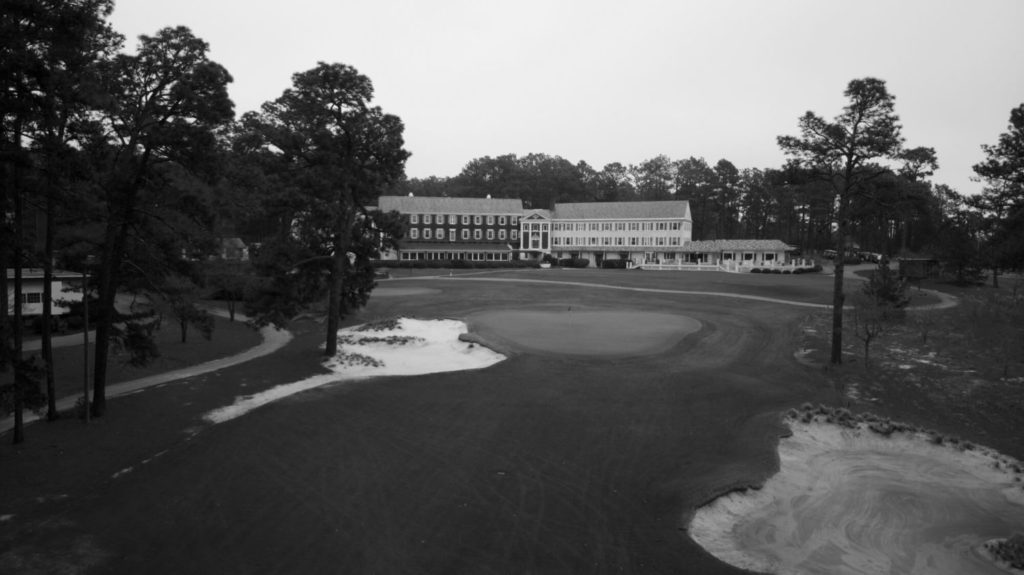
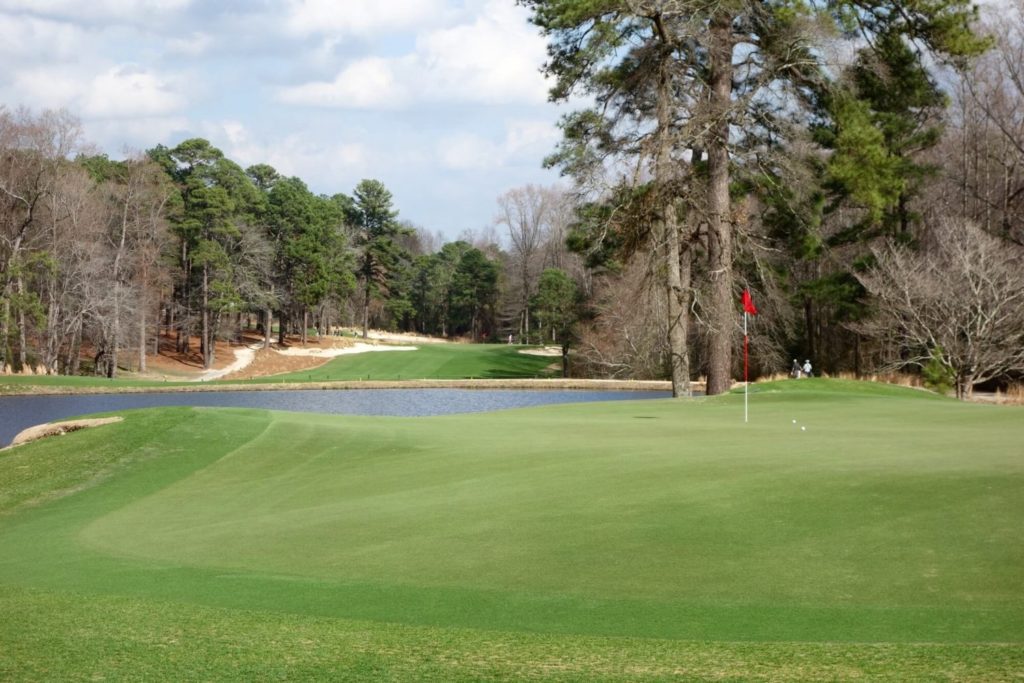

11 Comments on “Mid Pines Inn and Resort Review”
Hi Graylyn,
Out of curiosity, how would you split 10 rounds between Mid-Pines and Pine Needles? What do you feel are your favorite holes between the two properties? I know what I would pick, but I am curious what an expert like you would say!
-Adam
Hi Adam, really good question – and we can debate whether I’m an expert at another time ;) Personally, I’d split the rounds 7-3 Mid Pines to Pine Needles. I have a real affinity for Mid Pines and love the course, but that’s totally a personal opinion. From an architecture point of view, it would likely be closer to 6-4 or 5-5.
During my latest round our group had a similar debate about rounds between the two. Everyone was pretty split, but the best players in the group (all around +3 handicaps) favored Pine Needles over Mid Pines.
What’s your opinion on it?
Very interested in this one as I’m playing in the sand hills this summer, but only have time for 1 round between Pine Needles and Mid Pines…
My next review will be of Pine Needles, if that helps you make the choice! If I had only one, I’d play Mid Pines. I think it’s as charming and fun as they come. Pine Needles is a bigger course – one that can host championships, and some people prefer it. You really can’t go wrong, but for my money you’d find me at Mid Pines.
Thanks for the reply!
I have played each course twice (Pine Needles during the restoration, Mid Pines post-restoration), and I agree with a lot of what you wrote above.
I think I would be 7-3 or 6-4 Mid-Pines-Pine Needles, leaning toward 6-4 (is 6.5-3.5 an option?). I thought the green complexes were larger and more interesting at Pine Needles, but the route getting there and options from tee to green were more intricate at Mid-Pines.
Although I am definitely not a +3 handicap, I completely understand why your friends would prefer Pine Needles. As a longer hitter, my one knock on Mid-Pines was that I left the property with 3-4 clubs unused (I also used the exact same iron on 3/4 par 3’s). That was definitely not the case for me at Pine Needles.
Between the two courses, I think 11 at Pine Needles would have to be my favorite hole.
I’ve visited Mid Pines during the last part of the restoration by Kyle Franz… A friend of mine … Bret Brennan … was on his restoration crew. Stayed at the hotel just behind number 18 green and had a fantastic view of the golf course. I took extensive pictures while I was there but my camera and picture files have been stolen since that trip. I am in the golf course construction and renovation Industry and would give anything to be able to work with Kyle or some of the other great architects.
Brett took me to Pinehurst number 2 and Pine Needles while I was there also. Some of those pictures are saved on my Facebook page. Those memories are great ones for sure and this post certainly brought back that trip
Thank you so much
Tim
Hi Tim, It sounds like you’ve got a great connection to Mid Pines and the Pinehurst area. I’m glad this post brought back some good memories!
Hi Graylin, been reading and watching a lot of your St Andrews, Scotland data. It’s great! I am in the beginning stages of planning a trip for 8 golfers in 2019. We will apply for the advanced teatime this coming July. Then we will go from there as to planning our dates. I’m trying to stay away from the middleman option as it drives the price up significantly as you have mentioned.
Hi Rich, I think that sounds like a great plan! You should have no problem lining things up yourself planning this far ahead. Let me know how it goes. Best, Graylyn
Thanks Graylyn. I’m a caddy here in Hingham Massachusetts myself. Could you rank the months to visit Scotland. Specifically May June and September, which is the best month in your opinion? Thanks
Hi Rich, I’d say June, followed by September, followed by May. That answer can change though depending on where you want to go. St Andrews in September is slammed busy due to events and the Old Course is closed for a two-week period for the R&A Autumn Meeting.
Check out my full article on the best time of year to visit Scotland here: http://www.graylynloomis.com/best-time-year-visit-scotland-golf/